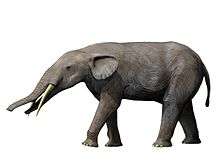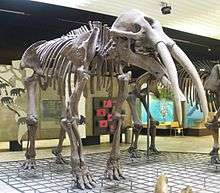Gomphotherium
Gomphotherium (/ˌɡɒmfəˈθɪəriəm/; "welded beast") is an extinct genus of proboscids from the Neogene and early Pliocene of Eurasia, Africa, and North America.[2]
| Gomphotherium | |
|---|---|
 | |
| Specimen of Gomphotherium productum at the AMNH | |
| Scientific classification | |
| Kingdom: | Animalia |
| Phylum: | Chordata |
| Class: | Mammalia |
| Order: | Proboscidea |
| Family: | †Gomphotheriidae |
| Genus: | †Gomphotherium Burmeister, 1837 |
| Species | |
|
Subgenus Gomphotherium
Subgenus Genomastodon
Incertae sedis
| |
| Synonyms | |
Description
G. productum is known from a 35-year-old male 2.51 m (8 ft 3 in) tall weighing 4.6 t (4.5 long tons; 5.1 short tons). Even larger is G. steinheimense, known from a complete 37-year-old male found in Mühldorf, Germany, which is 3.17 m (10.4 ft) tall and weighed 6.7 t (6.6 long tons; 7.4 short tons).[3] It had four tusks, two on the upper jaw and two on the elongated lower jaw. The lower tusks are parallel and shaped like a shovel and were probably used for digging up food from mud. Unlike modern elephants, the upper tusks were covered by a layer of enamel. Compared to elephants, the skull was more elongated and low, indicating that the animal had a short trunk, rather like a tapir's. These animals probably lived in swamps or near lakes, using their tusks to dig or scrape up aquatic vegetation. In comparison to earlier proboscids, Gomphotherium had far fewer molars; the remaining ones had high ridges to expand their grinding surfaces. Gomphotherium spp. inhabited dry wooded regions near lakes.
Taxonomy
The following cladogram shows the placement of the genus Gomphotherium among other proboscideans, based on hyoid characteristics:[4]
| ||||||||||||||||||||||||||||||||||
 Gomphotherium angustidens
Gomphotherium angustidens- Gomphotherium productum
 G. angustidens by Charles R. Knight
G. angustidens by Charles R. Knight G. angustidens skeleton
G. angustidens skeleton Skeletal restoration of G. productum (right) and G. steinheimense (left)
Skeletal restoration of G. productum (right) and G. steinheimense (left)
References
| Wikimedia Commons has media related to Gomphotherium. |
- Wang, Shi-Qi; Li, Yu; Duangkrayom, Jaroon; Yang, Xiang-Wen; He, Wen; Chen, Shan-Qin (2017). "A new species of Gomphotherium (Proboscidea, Mammalia) from China and the evolution of Gomphotherium in Eurasia". Journal of Vertebrate Paleontology. 37 (3): e1318284. doi:10.1080/02724634.2017.1318284.
- Wang, Wei; Liao, Wei; Li, Dawei; Tian, Feng (1 July 2014). "Early Pleistocene large-mammal fauna associated with Gigantopithecus at Mohui Cave, Bubing Basin, South China". Quaternary International. 354: 122–130. Bibcode:2014QuInt.354..122W. doi:10.1016/j.quaint.2014.06.036. ISSN 1040-6182.
- Larramendi, A. (2016). "Shoulder height, body mass and shape of proboscideans" (PDF). Acta Palaeontologica Polonica. 61. doi:10.4202/app.00136.2014.
- Shoshani, J.; Tassy, P. (2005). "Advances in proboscidean taxonomy & classification, anatomy & physiology, and ecology & behavior". Quaternary International. 126–128: 5–20. Bibcode:2005QuInt.126....5S. doi:10.1016/j.quaint.2004.04.011.